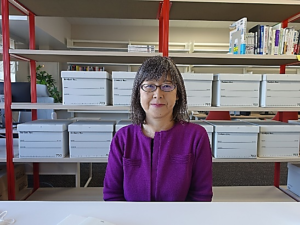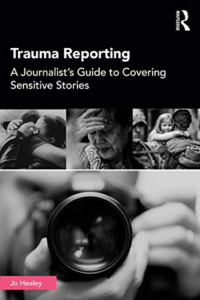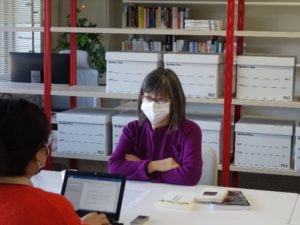2022.Feb.16
REPORTSBe Close with Vulnerable People to Create a Fairer Public Discourse Space:
An Interview with Michiko Kawahara, Project Professor of the Interfaculty Initiative in Information Studies (III) at the University of Tokyo
Atsuko Sano (Project Researcher of the B’AI Global Forum)
・Date: Thursday, December 9, 2021
・Venue: BAIROOM (office of the B’AI Global Forum)
[Sano]
Please tell us about your past career and current activities.
[Kawahara]
 I had been a newspaper reporter for 37 years until the spring of 2020. I graduated from university (Department of Social Psychology, Faculty of Letters, University of Tokyo) in 1983, and became a reporter for the Asahi Shimbun.
I had been a newspaper reporter for 37 years until the spring of 2020. I graduated from university (Department of Social Psychology, Faculty of Letters, University of Tokyo) in 1983, and became a reporter for the Asahi Shimbun.
My work as a reporter in the social affairs section lasted for a long time, but covering sexual assault led me to visit and listen to people who had lost family members or were victims themselves in accidents or unforeseen events. This was in the 1990s, and at the time, I was surprised to hear things like how criminal trials sometimes proceeded before victims even knew what was going on. I wrote articles focusing on the situation of victims who had been left behind in the criminal justice system, and by the time I wrote, the system had changed. It was a time when victim support was gradually expanding in Japan, and I learned a lot from many people.
In this process, the theme that remained as my own assignment was “Victims and Reporting.” While there was criticism of collective overheating of coverage, I was also wondering what I should do when some people said, “why didn’t you come to listen to us?” I felt that the first step was to listen to the experiences of those who had been reported on, so together with Ms. Shizue Takahashi, one of the bereaved families of the victims in the Tokyo subway sarin attack, I held a study group of volunteer reporters outside the company from 2000 to 2011. Instead of a Q&A session where reporters asked what they wanted to hear, the victims and their families first told us what they had actually experienced, and also what they found disagreeable and good reporting in detail.
 I was inspired from this experience, and compiled a book titled “Victims of Crime” Change the Press (Iwanami Shoten) in 2005 as an interim report. I hoped that someone would further deepen my thoughts on the subject, but things didn’t go so smoothly (laughs). I was so busy at the newspaper company that I didn’t have much time to acquire new knowledge, so after leaving the company, I started re-learning about “listening” and researching foreign initiatives. I was given the opportunity to teach a class at the III’s Undergraduate Research Student Program, and I am getting hints from the discussions with the students.
I was inspired from this experience, and compiled a book titled “Victims of Crime” Change the Press (Iwanami Shoten) in 2005 as an interim report. I hoped that someone would further deepen my thoughts on the subject, but things didn’t go so smoothly (laughs). I was so busy at the newspaper company that I didn’t have much time to acquire new knowledge, so after leaving the company, I started re-learning about “listening” and researching foreign initiatives. I was given the opportunity to teach a class at the III’s Undergraduate Research Student Program, and I am getting hints from the discussions with the students.
[Sano]
Perhaps the Trauma Reporting Study Group, which you are chairing at the B’AI Global Forum, is one of the activities you are focusing on after leaving the company. Could you tell us about the study group?
[Kawahara]
 As the first activity of this group, we’ re reading a book titled Trauma Reporting: A Journalist’s Guide to Covering Sensitive Stories (2019). We, some of which are journalists from newspapers and broadcasters and the others are researchers in journalism or other fields, read and report on each chapter, and then discuss based on our own experiences.
As the first activity of this group, we’ re reading a book titled Trauma Reporting: A Journalist’s Guide to Covering Sensitive Stories (2019). We, some of which are journalists from newspapers and broadcasters and the others are researchers in journalism or other fields, read and report on each chapter, and then discuss based on our own experiences.
This book was compiled by Jo Healey, who started up a training program at the British public broadcaster BBC. Based on the experiences of the interviewees and the practices of veteran interviewers, she makes concrete recommendations on how to fulfill the mission of journalism by interviewing people who have had traumatic experiences with consideration. With the help of researchers, the book also contains bits of knowledge about trauma.
It requires knowledge and training to listen to and share properly the stories of vulnerable people who have suffered physical and mental damage, such as victims of incidents, (sexual) violence and abuse, disaster victims, the families of the victims, and survivors and witnesses of war and conflict. I also believe that certain things can be prevented if the interviewer learns about them in advance.
In the past few years, the need to “empathize”, “sympathize” and “be close with you(yorisou)” has become increasingly important in the world of journalism. But what exactly does it mean? What should/shouldn’t we do? Sometimes the reporting of the facts may cause someone to suffer. On the other hand, there are reports that follow the stereotypical image of victims, portraying them based on the assumption that “this is what victims are like” without properly listening to them, causing disappointment and stress to the people being interviewed.
If we don’t have more discussion on the contents, “empathy”, “sympathy” and “be close with you(yorisou)”will be nothing more than just slogans that sound good.
Many of the examples in this book are from English-speaking countries, and there are cultural differences in reporting. However, beyond these differences, I feel that what I have learned while struggling in the field has been put into words. Based on the discussions at the study group, I would like to share the outcomes more widely in some way.
[Sano]
I feel that thinking about the concept of “be close with you(yorisou)” is a common issue in how to prevent abuse via social media these days.
[Kawahara]
 Perhaps it means to imagine the other person’s feelings……
Perhaps it means to imagine the other person’s feelings……
There are surely some aspects that could be improved by imagining and thinking “what if it were me?” Using harsh expressions as if you are denying the existence of the person may mean that you don’t even consider him/her as “human” in the first place.
As far as what I myself have realized, the experiences of those who have suffered unexpected disasters are far beyond my imagination. What they think and how they live after disasters are different for each person, and even for the same person, they will change over time. It is not so easy to figure out.
However, there is a deep-rooted stereotype in society that “victims behave like this” or “real victims would not do such things.” Even though this is not how they really are, there are also those who criticize and make judgments on others based on such assumptions. Perhaps we need to convey the reality of vulnerable victims more in the media.
Regarding “secondary damage,” which further hurts the victim after the incident, anyone who interacts with the victim may become a potential perpetrator. I feel that the impact of the secondary damage, which used to be just “heartless rumors in the neighborhood,” has been growing and becoming a whirl with high speed in recent years and threatening people. Taking an victim of an incident or an accident as an example, besides the primary damage caused by the incident/accident itself, there could be secondary damage: such as being treated without any consideration during the investigation process, exposed to hurtful remarks from the people around them with the intention of encouraging them and being caused by media interview. In the past, the secondary damage has been caused by the people around the victims, but now it has become a huge whirlpool, where strangers suddenly write their names on the web, say insulting words to them, and assume that they must be the culprits. I think that such secondary damage caused by social media is becoming increasingly serious.
 In the case of “encouragement”, the person may not have bad intentions. However, there is nothing that can be done even if people say, “you should not keep crying endlessly,” or “your child would not be happy even though the 49th day has passed (which is the boundary day of Buddhism).” On the other hand, the victims are expected to play the role of looking down and crying forever, and if they do not, they are sometimes bashed. People might say, “how dare a victim acts like that,” or if a victim starts a civil lawsuit, they talk as if he/she is just after money or exchanging human lives for money. Not everyone is kind, and not everyone is easy to live with. However, I think there are many things that can be prevented by knowing exactly the conditions of people in such situations.
In the case of “encouragement”, the person may not have bad intentions. However, there is nothing that can be done even if people say, “you should not keep crying endlessly,” or “your child would not be happy even though the 49th day has passed (which is the boundary day of Buddhism).” On the other hand, the victims are expected to play the role of looking down and crying forever, and if they do not, they are sometimes bashed. People might say, “how dare a victim acts like that,” or if a victim starts a civil lawsuit, they talk as if he/she is just after money or exchanging human lives for money. Not everyone is kind, and not everyone is easy to live with. However, I think there are many things that can be prevented by knowing exactly the conditions of people in such situations.
People involved in various professions, such as the police, lawyers, and mental health care providers, have learned a lot over the past 20 years or so, and have made a lot of efforts to minimize the secondary damage. However, people in the journalism and news industry, in my opinion, have still a lot of things to learn to prevent the damage. For example, if they know in advance how a traumatized person will react; the person in front of you will not always be crying, they may not be able to speak because they are frozen in their emotions, or they may become sick afterwards, they might be able to prevent damage and might not ask questions in a way that pushes them over the edge. There are many people who have a strong sense of self-blame even when it is not their fault at all, so avoiding questions that require them to take responsibility is also a good idea. There are still a lot of things that can be prevented with such knowledge, yet they are not well known in the world of journalists, that is the reality, I think.
The study group is currently only reading a book, but if we can share this knowledge in some way in Japan, I hope we can make progress in improving this situation.
It is not easy to change people’s consciousness, and in a sense, it sounds scary, but we must also consider a way to engage the consciousness of the majority.
[Sano]
How does the acquisition of skills for journalists to cover vulnerable people lead to the formation of a fair public discourse space, which is the goal of the B’AI Global Forum?
[Kawahara]
I consider it more of an attitude to them than a “skill,” but anyway, why is it important for journalists to understand the characteristics of people who have had traumatic experiences and know better options for interacting with them as an interviewer? One passive reason is to avoid causing as much secondary damage as possible.
But another positive reason is that we need to listen to people who are prone to prejudice and stereotypes, have difficulty speaking up, or whose voices are hard to reach, and tell their stories to society. If there are issues there, we need to sort them out and present them to society. We need to make that process a more reliable one. Unless we break down prejudices and stereotypes little by little, the difficulties of living for the people affected will continue even if some legal system is established.
 When I first started reporting on support for crime victims, the question that arose in my mind was, “why has the environment for victims in Japan lagged so far behind?” I think there is a similar aspect to the problems of leprosy and forced sterilization.
When I first started reporting on support for crime victims, the question that arose in my mind was, “why has the environment for victims in Japan lagged so far behind?” I think there is a similar aspect to the problems of leprosy and forced sterilization.
The problem that it is difficult for women’s voices and experiences to be used effectively in Japanese society could be improved to a certain extent by increasing the number of women in decision-making positions. Since women are not minorities in society as a whole, it should be possible to increase the number of women in decision-making positions. However, there are those who are few in number and are difficult to see or understand in the first place.
When there is a bias in the discourse that has previously been circulated in the world, trying to build something by incorporating the discourse of the world with AI will reproduce prejudices and stereotypes. I believe that the Trauma Reporting Study Group is one of the efforts to create a fairer public discourse space.